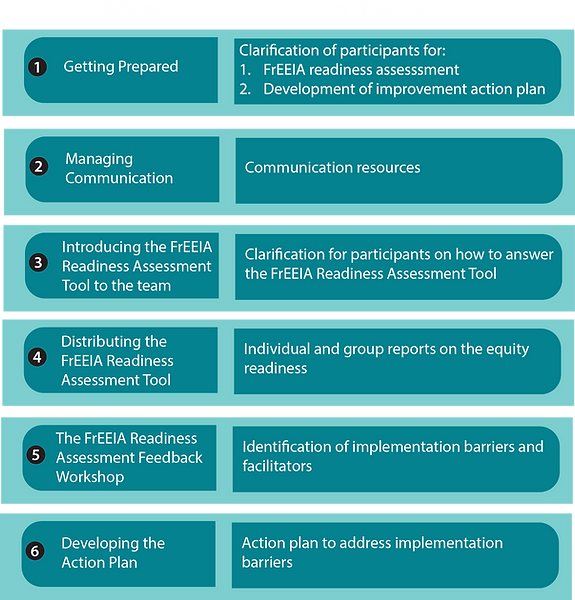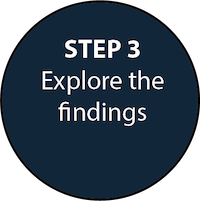The FrEEIA Readiness Assessment Tool
Facilitating the FrEEIA Readiness Assessment Tool process
Equity readiness ideally needs to be championed at all levels within bigger organisations, including by those in leadership positions. In addition, each team going through the FrEEIA Readiness Assessment Tool process will also need to have their own team champion to get people on board with this process more specifically. This will most likely be someone from the team that will be using it, or from the organisation responsible for implementing the intervention. If this champion is external to the team, they could also fulfil the role of the facilitator, and may do this for multiple teams within the organisation.
Both champion and facilitator carry the task of getting people on board with the FrEEIA Readiness Assessment Tool process and meaningfully engaged. Without the necessary buy-in, the process is unlikely to be effective in creating change. Champions and facilitators therefore need to ensure that teams come into the FrEEIA Readiness Assessment Tool process with a basic understanding of what equity is, why it is important, and how implementation tools can help to address equity barriers (CLICK HERE for more info).
A comprehensive guide to help facilitators work through the FrEEIA Readiness Assessment Tool process is available below.
An overview of the FrEEIA readiness assessment process

The FrEEIA Readiness Assessment Process
FOUR EASY STEPS

The FrEEIA Readiness Assessment Tool
Introduction
The FrEEIA Readiness Assessment Tool* is an implementation planning tool designed to facilitate equitable implementation of health interventions in Aotearoa New Zealand. It supports organisations and individuals to reflect on factors influencing implementation and to then develop strategies to remove any barriers to implementation, particularly those that might result in inequitable implementation.
* The tool is adapted from the Readiness Thinking Tool [Click to access] developed by the Wandersman Centre [Click to find out more]. The tools is made available under a Creative Commons License.
Overview of the Tool
The FrEEIA Readiness Assessment Tool comprises primarily of a list of 31 self-rated statements grouped according to the three components of organisational readiness – individual motivation, intervention-specific capacity and organisational capacity. It does this in four sections focusing on:
-
Individual readiness: the extent to which an individual is motivated to implement the intervention and make it equitable
-
Intervention-specific readiness: what is needed to make a particular intervention happen in an equitable way.
-
Organisational readiness (people): the roles, knowledge and skills needed to support equitable implementation
-
Organisational readiness (systems and processes): the systems & processes across the organisation that impact on equitable implementation.
The FrEEIA Readiness Assessment Tool also provides discussion points and questions intended for use in the facilitated team discussion after team members have completed the self-assessment individually. These will guide the team towards developing an action plan comprising strategies to aid equitable implementation and achieve equal outcomes
CLICK HERE to preview the FrEEIA Readiness Assessment Tool

Accessing the FrEEIA Readiness Assessment Tool




The tool is designed to give you a secure portal for your own team to complete the self-assessment.
There are three steps to follow:
-
Use the FrEEIA facilitators guide to support you through the steps in the data collection process and managing the feedback workshop.
-
Set up the contact details for the person who is managing the process
-
Determine which team members will be invited to complete the tool and enter these details into the portal.
The system then automatically sends email invites to people to complete the tool. Each person receives their own unique ID link. There are two follow up email reminders - one after 5 days and the other after 10 days. The assessment closes 14 days after the initial invite has been sent out.
The system then generates customised reports:
-
Each individual gets their own report. This shows their results versus the cohort average.
-
A cohort report is generated. This is sent to the person who set up the group and is managing the feedback process.

















